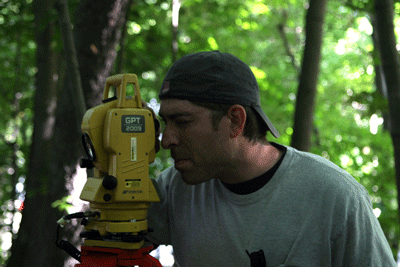Week 2
Hi, I’m Sean Gohman and I’m an entering Master’s student at Michigan Tech. Week two is upon us at the West Point Foundry and finally we are beginning to put shovels in the ground. The first week was mainly used for learning mapping techniques and getting a feel for the site and what our goals will be for the project. Luckily for us the weather made a turn for the better as well and we didn’t need to continually postpone work due to rain.
This field season the site is being broken into two very distinct areas of focus. The first area we are working on is a domestic property located nearby the foundry. The property consists of the main house, some wells, a garden, and an unidentified structural ruin. This ruin is the focus of excavation at the property since none of the known maps fully explain its purpose. Through the processes of excavation and mapping, we hope to find out if this was a servants quarters or something entirely different. As of the end of week two, the crew mapped the structure’s foundation walls and excavation units set up near a possible doorway and inside the cellar. The cellar floor is covered in timber that was probably from the roof caving in some time ago. It will take a while to dig though all the roofing beams. The doorway excavations yielded many artifacts including buttons, figurines, and punched mother-of-pearl.
The other focus of operations at the West Point Foundry is the Boring Mill located on the foundry property. The Boring Mill is one of the two oldest buildings at the site and luckily for us, was never torn down to make way for newer buildings during the foundry’s history. This allows us to look back to the original structure without having to disrupt more recent construction.
Our main goal in excavating the Boring Mill is to determine the exact location of a wall that may have supported water flumes that powered a massive water wheel, which drove the boring machines. By uncovering the location of the wall, architects and contractors will be able to stabilize it and insure it will stay standing for decades to come. The biggest obstacle of locating a wall that has begun to collapse is moving all of the rock and stone that once made up the upper half of the wall. It can be tiring, back-breaking work but sometimes it can reveal some big surprises as well. One team working on the north side of the wall has come across a very large granite block that at one time supported large machinery. This find has altered some of our plans but only for the better. This is how archaeology works. It takes patience, persistence, and an observant mind will to adapt to the situation at hand.
Next week the weather looks to be warm but not too humid. The perfect weather for the work we are doing. Hopefully by the end of next week we will have some more answers to the questions that have been raised in this week’s work. Often in this line of work the more you dig, the more questions you uncover.

The author of this week's post is Sean, who also did some surveying.



